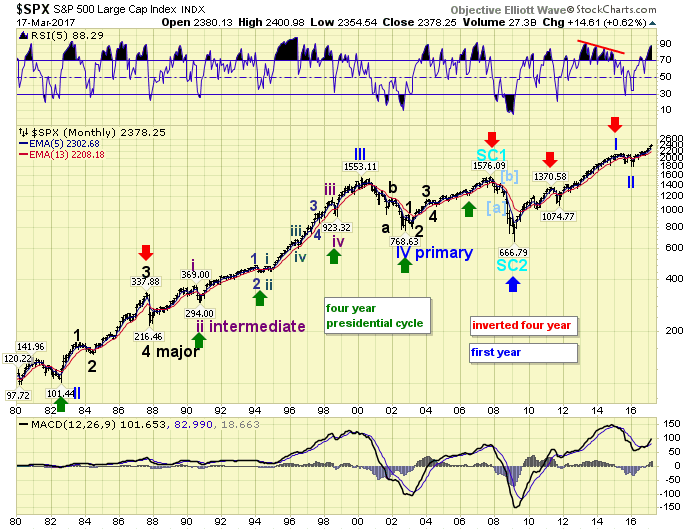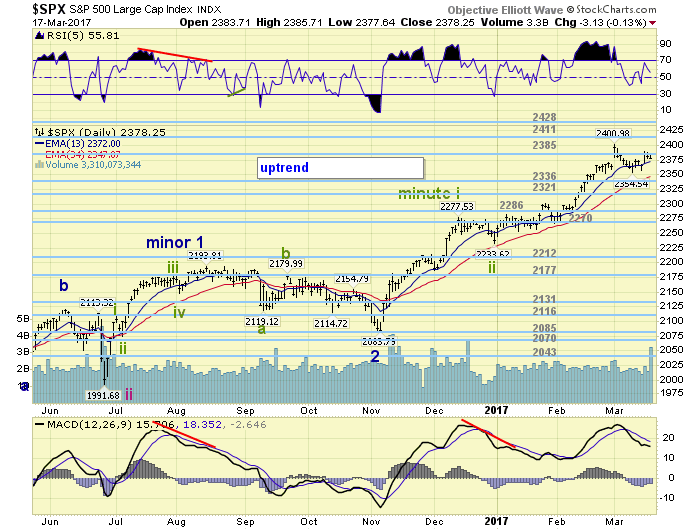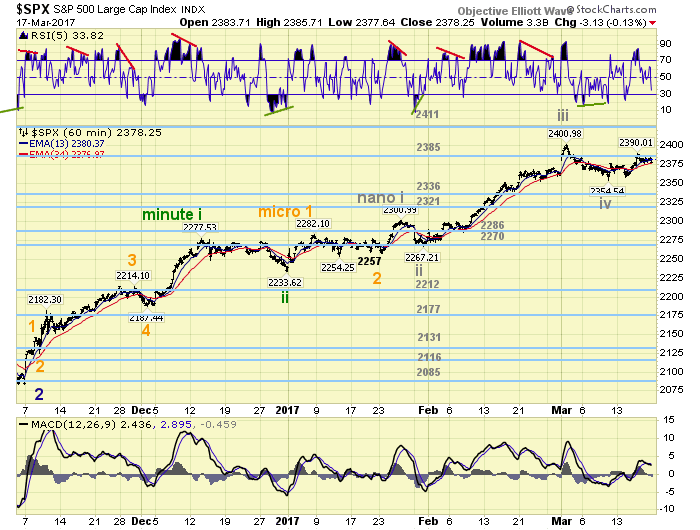Stock Market 4 Year Cycle
Stock-Markets / Stock Market 2017 Mar 18, 2017 - 02:55 PM GMTBy: Tony_Caldaro
 The market started the week at SPX 2373. After ticking up to SPX 2374 on Monday the market gapped down on Tuesday to SPX 2358. After that it rallied to SPX 2390, after the FED raised rates 25 bps to 1.0% on Wednesday. Then it pulled back to SPX 2378 to end the week. For the week the SPX/DOW gained 0.15%, and the NDX/NAZ gained 0.55%. Economic reports for the week were mostly positive. On the downtick: the NY/Philly FED, building permits, and the Q1 GDP estimate. On the uptick: the CPI/PPI, retail sales, business inventories, the NAHB, housing starts, capacity utilization, leading indicators, consumer sentiment, the WLEI, plus weekly jobless claims improved. Next week’s reports will be highlighted by durable goods orders and housing. Best to your week!
The market started the week at SPX 2373. After ticking up to SPX 2374 on Monday the market gapped down on Tuesday to SPX 2358. After that it rallied to SPX 2390, after the FED raised rates 25 bps to 1.0% on Wednesday. Then it pulled back to SPX 2378 to end the week. For the week the SPX/DOW gained 0.15%, and the NDX/NAZ gained 0.55%. Economic reports for the week were mostly positive. On the downtick: the NY/Philly FED, building permits, and the Q1 GDP estimate. On the uptick: the CPI/PPI, retail sales, business inventories, the NAHB, housing starts, capacity utilization, leading indicators, consumer sentiment, the WLEI, plus weekly jobless claims improved. Next week’s reports will be highlighted by durable goods orders and housing. Best to your week!
FOUR-YEAR PRESIDENTIAL CYCLE
The four-year Presidential cycle has been used for quite a long time in anticipating major market lows. Since the year 1938 it has worked quite well. The cycle suggests a significant stock market low occurs in the second year of every President’s term. Then the market rises for a few years until the making another low in the second year of the next Presidential term. Counting the year 1938, there have been 20 potential occurrences. This cycle has been accurate 65% of the time. Recent dates include 1982, 1990, 1994, 1998 and 2002. Early in this cycle series, 1950, 1954, and then again in 2010, the cycle bottomed in the first year of the Presidential term, i.e. 1949, 1953 and 2009. This accounts for an additional 15% of the cycle lows. Bringing the total to 80%.

The other 20% of the time, which has confounded many of its followers, the cycle has inverted. In other words, it did not end with a major stock market low but a major stock market high. This first appears in 1958, then reappears in 1986, 2006 and 2014. One could also suggest that 2010 worked this way as well. Instead of making a significant market low on these dates, the second year of a Presidential term, the market made a significant high in the third year of the Presidential term, i.e. 1959, 1987, 2007 and 2015. This inversion counts for the last 20% of the 20-event series. What does this cycle suggest going forward?
A new President just entered the White House in 2017. With the market at all-time highs, and a significant low having just occurred in 2016, it is quite unlikely his first year will see another significant low. The most likely target year for a significant low would be next year, 2018, his second year in office. If a significant low does not occur next year either. Then a significant market top should occur in the year 2019, his third year in office. In summary: there is an unlikely 15% chance of a significant low in 2017; a probable 65% chance of a significant low in 2018; and a highly probable, if neither of the first two occur, 20% chance of a significant high in 2019. This is the modern day 4-year President Cycle.
LONG TERM: uptrend
The long term count continues to unfold as labeled. A Super cycle low in 2009 at SPX 667. A Primary wave I high of Cycle wave [1] at SPX 2135 in 2015. A Primary wave II low at SPX 1811 in 2016. Since then a Primary wave III underway, with this bull market probably only Major wave 1 of Primary III. Quite a long term bullish scenario being projected by OEW.

From the Primary II low in 2016 we have labeled Intermediate waves i and ii completing in April and June respectively. Minor waves 1 and 2 of Intermediate iii completing in August and November. Minor wave 3, from the November low, continues to unfold.
MEDIUM TERM: uptrend
This Minor wave 3 uptrend began in November at SPX 2084. It is naturally dividing into five Minute waves. Quite similar to Minor wave 1, but obviously on a much larger scale. Minute waves i and ii ended in mid-to-late December at SPX 2278 and 2234 respectively. Minute wave iii has been underway, and subdividing even further, since then. This uptrend has lasted twice as long as the two previous uptrends, and has travelled more points.

At the recent SPX 2401 high Minute iii is still about 27 points shorter than Minute i. Normally third waves are the longest. At SPX 2428 Minute iii will equal Minute i. So it appears this uptrend, on this point alone, has further to go. Despite the slowdown in upside momentum as noted by the daily MACD. Medium term support is at the 2336 and 2321 pivots, with resistance at the 2386 and 2411 pivots.
SHORT TERM
Minute wave iii has been subdividing also. This is what happens when uptrends continue to extend in time. While Minute wave i was a relatively simple five Micro wave (orange) structure, Minute iii has a Micro 3 that has also subdivided.

The count we have been tracking is that Nano wave v of Micro 3 is underway. When it makes new highs and concludes, Micro wave 3 would have ended. Then after a Micro wave 4 pullback, a Micro 5 rally should complete Minute wave iii. If you are still following, a Minute iv pullback will then lead to a Minute v rally and the end of the Minor wave 3 uptrend. Then the market should enter a downtrend and decline at least 5%, maybe more.
Short term support remains at SPX 2353/55/58 and the 2336 pivot, with resistance at the 2385 pivot and SPX 2401. Short term momentum ended the week below neutral and heading to oversold. Best to your trading next week!
FOREIGN MARKETS
Asian markets were mostly higher and gained 1.3%.
European markets were all higher and gained 1.3%.
The DJ World index gained 1.3%, and the NYSE gained 0.8%.
COMMODITIES
Bonds remain in a downtrend but gained 0.5%.
Crude is also in a downtrend but gained 1.7%.
Gold remains in a downtrend too but gained 2.4%.
The USD is in an uptrend but lost 1.0%.
NEXT WEEK
Wednesday: the FHFA index and existing home sales. Thursday: weekly jobless claims and new home sales. Friday: durable goods orders. Quiet week. Best to your weekend and week!
CHARTS: http://stockcharts.com/public/1269446/tenpp
After about 40 years of investing in the markets one learns that the markets are constantly changing, not only in price, but in what drives the markets. In the 1960s, the Nifty Fifty were the leaders of the stock market. In the 1970s, stock selection using Technical Analysis was important, as the market stayed with a trading range for the entire decade. In the 1980s, the market finally broke out of it doldrums, as the DOW broke through 1100 in 1982, and launched the greatest bull market on record.
Sharing is an important aspect of a life. Over 100 people have joined our group, from all walks of life, covering twenty three countries across the globe. It's been the most fun I have ever had in the market. Sharing uncommon knowledge, with investors. In hope of aiding them in finding their financial independence.
Copyright © 2017 Tony Caldaro - All Rights Reserved Disclaimer: The above is a matter of opinion provided for general information purposes only and is not intended as investment advice. Information and analysis above are derived from sources and utilising methods believed to be reliable, but we cannot accept responsibility for any losses you may incur as a result of this analysis. Individuals should consult with their personal financial advisors.
Tony Caldaro Archive |
© 2005-2022 http://www.MarketOracle.co.uk - The Market Oracle is a FREE Daily Financial Markets Analysis & Forecasting online publication.



